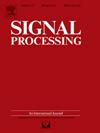通过流形优化块坐标下降实现模拟数字混合阵列的异形图案合成
IF 3.4
2区 工程技术
Q2 ENGINEERING, ELECTRICAL & ELECTRONIC
引用次数: 0
摘要
模拟数字混合(HAD)架构在系统性能和硬件复杂性之间进行了明智的权衡,是实现大规模阵列的一种有前途的方法。本文通过最小化期望模式与实际模式之间的信号匹配误差,研究了 HAD 阵列的信号振型。由于模拟和数字权重的非凸约束以及非凸非光滑目标函数,由此产生的编码设计是 NP-困难的。为了解决这个问题,我们利用块坐标下降(BCD)和黎曼流形优化创建了一种高效算法。首先,我们通过引入一个单模辅助变量,将目标函数等效为一个平滑的二次函数。随后,我们在 BCD 框架下交替优化缩放因子、数字权重、模拟权重和辅助变量,其中模拟权重和辅助变量的同步更新被重铸成单模态受限二次方程规划,并通过黎曼牛顿法有效求解,而数字权重则通过拉格朗日乘法得到全局最优解。我们还推导出了该算法的明确收敛条件。数值结果表明,与其他算法相比,所提出的算法性能更优越,收敛速度更快,并能以显著减少的射频链产生与全数字阵列几乎相同的主波增益。本文章由计算机程序翻译,如有差异,请以英文原文为准。
Shaped pattern synthesis for hybrid analog–digital arrays via manifold optimization-enabled block coordinate descent
Hybrid analog–digital (HAD) architecture is a promising means to realize large-scale arrays owing to the judicious trade-off between system performance and hardware complexity. This paper investigates the beampattern shaping of HAD arrays through minimizing the beampattern matching error between desired and actual patterns. Due to the nonconvex constraints on analog and digital weights and the nonconvex nonsmooth objective function, the resultant codesign is NP-hard. To address this issue, we create an efficient algorithm by leveraging block coordinate descent (BCD) and Riemannian manifold optimization. We first equivalently represent the objective function as a smooth bi-quadratic function by introducing a uni-modulus auxiliary variable. Subsequently, we alternatingly optimize the scaling factor, digital weights, analog weights and auxiliary variable under the BCD framework, where the simultaneous update of analog weights and auxiliary variable is recast as uni-modular constrained quadratic programming which is efficiently solved by Riemannian Newton method, and the digital weights have a global optimal solution via Lagrangian multiplier method. We also derive an explicit convergence condition of this algorithm. Numerical results demonstrate that the proposed algorithm has superior performance and faster convergence speed than alternative algorithms, and produces nearly the same mainlobe gain as fully digital arrays with significantly fewer radio-frequency chains.
求助全文
通过发布文献求助,成功后即可免费获取论文全文。
去求助
来源期刊

Signal Processing
工程技术-工程:电子与电气
CiteScore
9.20
自引率
9.10%
发文量
309
审稿时长
41 days
期刊介绍:
Signal Processing incorporates all aspects of the theory and practice of signal processing. It features original research work, tutorial and review articles, and accounts of practical developments. It is intended for a rapid dissemination of knowledge and experience to engineers and scientists working in the research, development or practical application of signal processing.
Subject areas covered by the journal include: Signal Theory; Stochastic Processes; Detection and Estimation; Spectral Analysis; Filtering; Signal Processing Systems; Software Developments; Image Processing; Pattern Recognition; Optical Signal Processing; Digital Signal Processing; Multi-dimensional Signal Processing; Communication Signal Processing; Biomedical Signal Processing; Geophysical and Astrophysical Signal Processing; Earth Resources Signal Processing; Acoustic and Vibration Signal Processing; Data Processing; Remote Sensing; Signal Processing Technology; Radar Signal Processing; Sonar Signal Processing; Industrial Applications; New Applications.
 求助内容:
求助内容: 应助结果提醒方式:
应助结果提醒方式:


